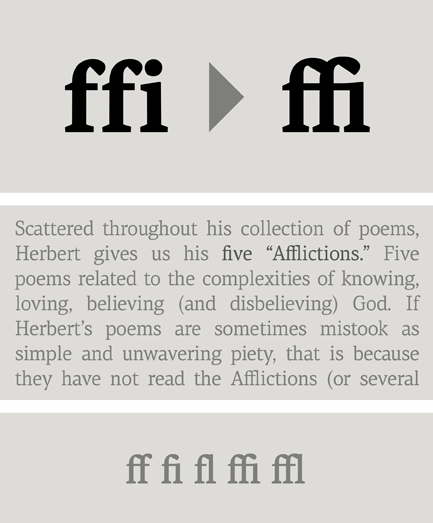




Specimen
Test Driver
Centro Serif Condensed
Centro Serif Condensed is part of a larger type system that includes a compressed and an extra condensed version which all together complement the award-winning Centro Serif Pro type family. It was originally developed for the redesign of the Financial Times (Deutschland) newspaper in order to offer a strong readable custom font family which managed to retain the serious reputation of the newspaper.
€249.00 complete family
Centro® Serif Condensed
Copyright ©2015
Designer: Panos Vassiliou
Centro Serif Condensed is part of a larger type system that includes a compressed and an extra condensed version which all together complement the award-winning Centro Serif Pro type family. It was originally developed for the redesign of the Financial Times (Deutschland) newspaper in order to offer a strong readable custom font family which managed to retain the serious reputation of the newspaper. Its robust, low contrast characteristics enhance its readability at small sizes. The angular slanted serifs as well as the abrupt cuts at the joints, while they foster a distinct identity at display sizes, they mellow down and tend to look a lot like curves at small sizes. At the same time, the overpowering effect of the angular serifs is balanced by the ‘tear-shaped’ ball terminals in letters like ‘c’, ‘f’. The x-height is larger than usual which makes it more legible at smaller sizes. Finally, the stress is not quite vertical but slightly inclined. Centro Serif gives you the essence of a very clean, expressive, legible and modern set of typefaces which makes it an ideal choice for newspapers and magazines. Centro Serif Condensed comes with 8 styles including italics, whereas the Centro Serif type system offers a comprehensive range of 32 font variations.
Ligatures : Replaces a sequence of glyphs with a single glyph, creating a professional-looking text with no peculiar collisions among letters. This feature covers the standard f-ligatures, as well as few other ones used in normal conditions.

Oldstyle figures : Changes selected figures from the default lining to oldstyle i.e. numbers of
varying height. These are appropriate for use with lowercase text. They come in two different styles:
tabular and proportional. Tabular figures have equal widths (useful for tables, so that numbers line
up from one line to the next) whereas proportional have varying widths and are basically used within a sentence.
Lining figures : This feature changes selected figures from oldstyle to the default lining form. Lining figures are numbers which fit better with all-capital text and they are of the same height as capitals or a bit smaller. They also come in two different styles: tabular and proportional.
Proportional figures : Replaces selected figure glyphs which are set on tabular widths (lining or oldstyle), with corresponding glyphs set on proportional widths (lining or oldstyle).
Tabular figures : Replaces selected figure glyphs which are set on proportional widths (lining or oldstyle), with corresponding glyphs set on tabular widths (lining or oldstyle).

SCRIPTS
1250 Eastern European , 1252 Latin 1 , 1254 Turkish , 1257 BalticSUPPORTED LANGUAGES
Albanian, Bosnian (Latin), Croatian, Czech, Hungarian, Polish, Romanian, Slovak, Slovenian, Sorbian, Afrikaans, Alsatian, Basque, Bislama, Breton, Catalan, Chamorro, Danish, Dutch, English, Faroese, Finnish, Flemish, Franco-Provencal, French, Frisian, Friulian, Galician, German, Greenlandic, Icelandic, Indonesian, Irish, Italian, Ladin, Latin, Luxembourgish, Malay, ManxGaelic, Norwegian (Bokmål), Norwegian (Nynorsk), Occitan, Portuguese, Rhaeto-Romance, Romansh, Sami (Inari), Sami (Lule), Sami (Skolt), Sami (Southern), ScottishGaelic, Spanish, Swahili, Swedish, Tagalog, Walloon, Welsh, Azeri (Latin), Kurdish (Latin), Turkish, Uzbek (Latin), Estonian, Latvian, LithuanianNAME
PF Centro Serif CondensedFORMAT
OpenType PSPACKAGE
Family of 8 fonts (also available as separate weights)GLYPHS
459 glyphs /font
PRO FEATURES
Standard f-Ligatures, Oldstyle Figures (tabular/proportional), Lining Figures (tabular/proportional)
PRICE
family: €249.00single weight: €49.00